The Jacobsthal numbers up to 1015 :
1, 3, 5, 11, 21, 43, 85, 171, 341, 683, 1365, 2731, 5461, 10923, 21845, 43691, 87381, 174763, 349525, 699051, 1398101, 2796203, 5592405, 11184811, 22369621, 44739243, 89478485, 178956971, 357913941, 715827883, 1431655765, 2863311531, 5726623061, 11453246123, 22906492245, 45812984491, 91625968981, 183251937963, 366503875925, 733007751851, 1466015503701, 2932031007403, 5864062014805, 11728124029611, 23456248059221, 46912496118443, 93824992236885, 187649984473771, 375299968947541, 750599937895083.
Distribution of the remainders when the numbers in this family are divided by n=2, 3,..., 11. (I took into account 10000 values, from 1 to 1.33⋅103010).
| n\r | 0 | 1 | |||||||||
|---|---|---|---|---|---|---|---|---|---|---|---|
| 2 | 0 | 10000 | 2 | ||||||||
| 3 | 3333 | 3333 | 3334 | 3 | |||||||
| 4 | 0 | 5000 | 0 | 5000 | 4 | ||||||
| 5 | 2500 | 5000 | 0 | 2500 | 0 | 5 | |||||
| 6 | 0 | 3333 | 0 | 3333 | 0 | 3334 | 6 | ||||
| 7 | 1666 | 3333 | 0 | 1667 | 1667 | 1667 | 0 | 7 | |||
| 8 | 0 | 1 | 0 | 5000 | 0 | 4999 | 0 | 0 | 8 | ||
| 9 | 1111 | 1111 | 1111 | 1112 | 1111 | 1111 | 1110 | 1111 | 1112 | 9 | |
| 10 | 0 | 5000 | 0 | 2500 | 0 | 2500 | 0 | 0 | 0 | 0 | 10 |
| 11 | 2000 | 2000 | 0 | 1000 | 0 | 1000 | 1000 | 0 | 1000 | 0 | 2000 |
A pictorial representation of the table above

Imagine to divide the members of this family by a number n and compute the remainders. Should they be uniformly distributed, each remainder from 0 to n-1 would be obtained in about (1/n)-th of the cases. This outcome is represented by a white square. Reddish (resp. bluish) squares represent remainders which appear more (resp. less) frequently than 1/n.
e-mail: info -at- numbersaplenty.com • Privacy notice • engine limits